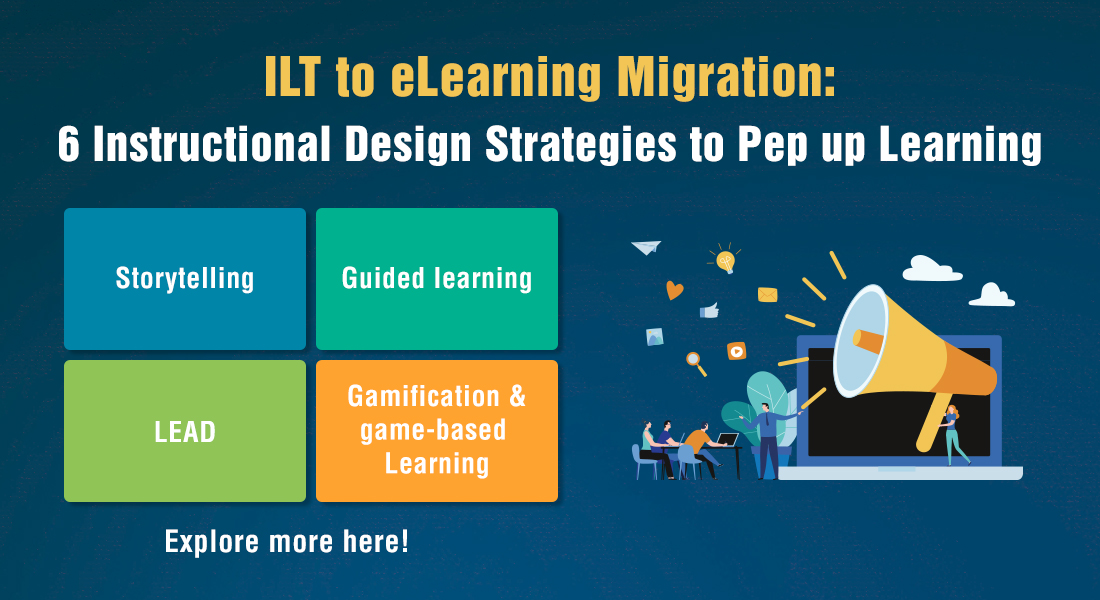7 Steps for the Rapid Conversion of ILT Material to Online Learning

Training managers often face issues such as training employees in a short time and learners not turning up for Instructor-Led Training (ILT) sessions. Many companies are converting their lengthy ILT sessions to engaging online courses to overcome these challenges. Many assume moving instructor notes and classroom teaching material to be delivered on computers is online training. But that’s not the whole story. A lot of intricacies are involved in converting your ILT to online training.
Here is the step-by-step process for you to convert your ILT resources to meaningful online training. Get-set-go!
1. Examine Training Needs
Reviewing your training needs before converting the existing ILT to online training.
Identify training goals in terms of content, learning experience, timelines and more, to design effective online learning. This exercise will clearly help you know what your employees expect from the training and you can design online training accordingly.
2. Set Learning Objectives
While converting classroom training, there could be a deviation from training goals, so it’s always better to revisit your learning objectives. Learning objectives precisely tell what learners/employees should be able to do on completion of the eLearning course. They help instructional designers develop your online training in the right direction.
According to American psychologist and author Robert Mager, ‘Performance’, ‘Conditions’ and ‘Criterion’, help create meaningful learning objectives.
Consider the example: Be able to fill the form using MS Excel before the timer runs out.
In this example, performance is filling the from; condition is filling it using the specified tool – Excel; criterion is filling it within the stipulated time. Learn more about learning objectives in this handy eBook.
3. Analyze ILT Material
Once you define the learning objectives, you have to analyze the ILT resources, such as instructor notes, PowerPoint presentations, training manuals, and more. This exercise helps determine whether the available content is relevant, what portions need to be included and what can be omitted from the course. Content analysis is a very important step in the development of an eLearning course.
4. Organize the Content
Dumping the instructor notes or PowerPoint decks in an authoring tool and developing a course doesn’t make sense. You need to arrange the content in a logical flow and chunk it in order to convey the clear idea, with a definite objective/purpose.
Make an outline with the logical flow of topics, dividing them into modules. Once you arrange the content, you may find gaps. PowerPoint slides contain only around 50% of the instructional information, the instructor conveys the remaining 50% orally. Taking the Subject Matter Expert’s will help you bridge content gaps.
5. Identify the Training Delivery Format
While converting ILT to online training, you need to identify the suitable format you can present in. Usually, you can convert the ILT in to three formats.
- Self-paced learning is an asynchronous format, where the instructor isn’t available and learners will interact with the content, directly. Here, your learners have the flexibility of access to online training anywhere, anytime.
- In Synchronous Learning learners and the instructor can login at the same time from different places. It usually happens through video/audio conferencing. Collaborative learning is also possible in this format.
- Blended Learning is when you combine self-paced, synchronous, and ILT or any two training formats. If eLearning and ILT are used individually, they have their disadvantages. So, it’s essential to blend learning delivery modes to ensure the best training to your employees.
6. Apply Suitable Strategies
Without applying the right instructional strategy, the conversion of ILT to online learning won’t yield the expected results. Presenting content in an easy to learn way, increasing the effectiveness of content using media, and providing opportunities for practice all come under the strategies used in online training.
- Instructional Design Strategy: To overcome the limitations in self-paced learning, you have to simplify complex information for effective learning. Instructional designers will use scenarios, case studies, simulations and other techniques to do this.
- Audio-Visual Strategy: You need to design the Graphical User Interface (GUI), and multimedia elements according to the organization-specific requirements. Your online learning course should have the right mix of text, video, audio, graphics and images to cater employees of different learning styles.
- Assessment Strategy: You need to formulate the right assessment strategy to trust learners and provide feedback. This completes the learning cycle and reinforces learning. Assessments should be aligned with the learning objectives and designed accordingly. Use appropriate question types such as drag and drop, matching exercises, and more – don’t be restricted to multiple choice questions.
7. Use the Right Rapid Authoring Tools
E-learning authoring tools play a key role in the rapid conversion of your ILT into interactive online learning. They make it easy to include interactivities, images, videos, audio and other multimedia elements, without programming knowledge.
Based on the training requirement and strategy, you can decide the authoring tool to use. If you have limited knowledge on rapid authoring tools, it’s better to take the help of an eLearning vendor/partner.
Here a few pointers on selecting the right authoring tool to convert ILT to eLearning:
Articulate Storyline and 360 is the most preferred tool to convert ILT to eLearning. You can develop product knowledge training, sales training, compliance training, safety training, translate courses, and more with this tool.
Adobe Captivate is a pro in creating stunning software simulations. It is the best option to develop ERP training, software training, technical process/systems training, and responsive courses.
Lectora is best known for its HTML5 output and simplifies the translation of online training courses into various languages.
If you want to start e-learning in your organization, start by converting your ILT resources. Don’t restrict your learners to the classroom, take learning to their desks. It will reduce your training costs drastically and improve learning outcomes.





